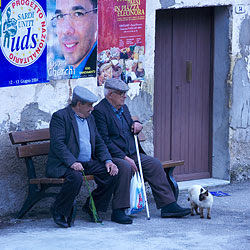- Set the camera so that it corrects for any color temperature/white balance issues in the image. Go to see Mr. Hiller if you want to learn how to do that.
- If you have already taken the shot and the image has an orange, blue, green, etc tint to it you can fix the picture after the fact with such tools as iPhoto or Photoshop.
- iPhoto
- Select an image with white balance issues
- Edit
- Adjust
- Temperature - This slider will allow you to shift to cooler or warmer tones
- Photoshop
- The most stunning way is to ...
- Select an image with white balance issues
- Image->Adjustments->Levels
- Click on the eye dropper on the lower right (the far right one that says "Set White Point"
- In the image click on something that should be white
- It will automatically correct the image with that point being plain white
There are many more ways to fix this in Photoshop!
Assignment ... on your blog, provide two images ... the first, any image (any source) with a white balance issue. The second, corrected by one of the methods above. Explain what you used as your "white point", what was causing the original color issue, and what you did to fix it.
- Here is a sample image. There is a blue tint which is very common in shade. You may use this image for your image to correct, or take or find another.


